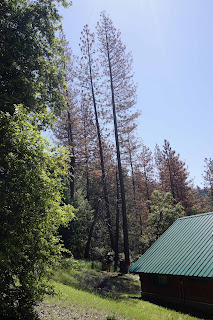Dale Matson
All photographs and video taken with Sony RX1R
Click On Photographs To Enlarge
Small Sample Of The Die-off Below Our Property
All photographs and video taken with Sony RX1R
Click On Photographs To Enlarge
Small Sample Of The Die-off Below Our Property
My wife and I built a cabin 10 years ago on property we have
owned for 15 years. During that time we have cut down dead pines, which we also
use in our woodstove for winter heating.
The last four years
of drought combined with the native bark beetles have created a perfect storm
of die-off. The Sierra and Sequoia National Forest areas have particularly been
hard hit with millions of standing dead conifers as potential fuel for massive
wildfires. I have noticed this die-off especially at the 4,000’ to 5,000’ elevations,
which have received much less, rain and little snow during the four years of
drought.
The last two years in particular the die off has been very evident and our property has not been spared the ravages of this disaster. Although governor Brown has declared this to be a disaster, no help has been offered to property owners who are faced with the enormous task of removing the dead standing trees. Another problem is that the tree removal companies are overwhelmed with the requests for work from homeowners. I made several phone calls to tree outfits that did not even return my calls.
I finally got in touch with Will from the Sierra Nevada Tree
Service who came out and looked at the dead trees in the developed portion of
our seven-acre parcel. My neighbors recommended him. We are in this together
and what makes my property safer makes their property safer also.
My chief concern was the cabin area and our water tanks and
pressure tank located above the cabin. My concern was twofold. There is the
obvious fire danger but also the risk of a dead tree falling on our cabin or
tanks. This area was logged years ago so the current trees have been planted
and are close together. Many trees are up to 100’ tall and taller. They stand
nearly vertical and unless you are a professional logger, it is not a good idea
to drop any of these huge trees. Standing dead trees are worse than dead trees
on the ground. Crown fires in standing dead trees spread fast and are more
difficult to control.
Will agreed to come out and believed he could drop all of
the dead trees near my areas of concern in a day’s time. Some trees would just
be dropped downhill into the woods, limbed and left to rot. Others would be
dropped, limbed and the brush broadcast by the chipper onto the ground. The
logs would be stacked away from the structures. Will had 2 loggers with him, a
12” chipper and a skid steer loader on tracks with jaws for picking up the
logs.
It was a warm day even at our location, which is about
4,300’ in elevation. They needed to put a rope high in one tree and used a
pneumatic gun to send a line high into the tree. They attached a haul line to
it and used it to guide the tree down safely. I helped some but worked in other
areas mostly by myself. It is simply amazing what young men can accomplish
working hard for an entire day. The trees are down, my structures are safer and
my neighbors have additional security from fires. This is dangerous work and I
am thankful that things went well for the crew.
Beginning Work
Timber!
Working Another Area By Myself
An Upside: A Better View SSE
Cleared East Side Of Cabin
Stacking Dead Logs By Water Tanks
Removing Dead Trees Along Drive
Two Trees Downed Together
Will told me that the newly dead trees are the safest to
work with and that once they have been standing dead for five years, it will
not be safe to remove those trees which will be rotten and not dependable to
cut.
As I reflect further on this it seems like two of the largest recent wildfires in California, the Rim Fire (Stanislaus National Forest) and the Rough Fire (Sierra National Forest) were on USFS land. To what extent can these fires be attributed to management practices of the USFS? There is an interesting report from congress indicating that the State forests are better managed.
http://naturalresources.house.gov/newsroom/documentsingle.aspx?DocumentID=321290
As I reflect further on this it seems like two of the largest recent wildfires in California, the Rim Fire (Stanislaus National Forest) and the Rough Fire (Sierra National Forest) were on USFS land. To what extent can these fires be attributed to management practices of the USFS? There is an interesting report from congress indicating that the State forests are better managed.
http://naturalresources.house.gov/newsroom/documentsingle.aspx?DocumentID=321290





























I found your pictures and write up fascinating. When I drive the Sierra foothills and see the mind boggling number of dead trees I wonder how people are dealing with it. Now I know! Thanks.
ReplyDeleteCarol,
ReplyDeleteThanks for your kind words. There are estimated to be over 20 million dead conifers so far. Governor Brown has declared the dead and dying trees to be an emergency but there are no provisions to assist private landowners.
https://www.gov.ca.gov/docs/10.30.15_Tree_Mortality_State_of_Emergency.pdf
It appears that nature is moving toward a climax forest sooner than we expected.